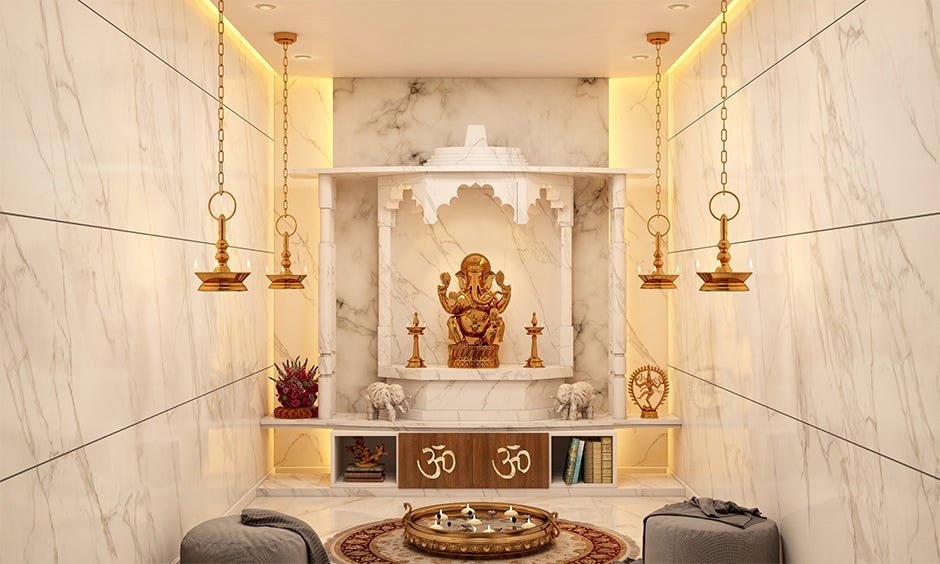For many, the home is not just a physical space but a sanctuary that reflects the values, beliefs, and spirituality of its inhabitants. Designing a temple within your home provides a dedicated space for introspection, meditation, and spiritual connection. In this article, we explore the thoughtful design considerations and elements that contribute to creating a sacred haven within your home.
Choose a Sacred Space:
Begin the design process by selecting a space within your home that resonates with tranquility and peace. It could be a spare room, a corner of the living room, or even a niche under a staircase. The key is to choose an area where you can establish a sense of serenity and separation from the daily hustle and bustle.
Sacred Geometry:
Incorporate sacred geometry into the design of your home temple. Shapes like circles, squares, and triangles hold symbolic significance in many spiritual traditions. Mandalas, representing the universe, and yantras, geometric patterns used in meditation, are excellent choices for bringing harmony and balance to the space.
Altar Design:
The altar serves as the focal point of your home temple. Select a simple yet meaningful design that resonates with your spiritual beliefs. Whether it’s a wooden table, a stone slab, or a dedicated shelf, the altar should provide a clean and uncluttered surface for your sacred objects, images, or idols.
Sacred Symbols and Icons:
Infuse your home temple with symbols and icons that hold personal or cultural significance. Whether it’s religious idols, statues, or sacred texts, these elements contribute to the spiritual ambiance of the space. Display them with intention and arrange them in a way that creates a harmonious visual composition.
Consider Natural Elements:
Bring the beauty of nature into your home temple with the inclusion of natural elements. Incorporate plants, flowers, or even a small water feature to add a sense of vitality and grounding. Natural elements connect the sacred space to the broader rhythms of life and creation.
Lighting for Ambiance:
Lighting plays a crucial role in setting the mood for your home temple. Opt for soft and warm lighting to create a serene and inviting atmosphere. Consider using candles, lanterns, or string lights to enhance the ambiance and create a sacred glow within the space.
Color Palette:
Choose a color palette that resonates with your spiritual practice. Soft and muted tones such as whites, blues, and greens are commonly associated with tranquility and spiritual connection. However, personal preferences and cultural influences should guide your choice of colors to create a meaningful and personalized environment.
Comfortable Seating:
Create a comfortable and inviting space for meditation and contemplation by incorporating seating options that align with your preferences. Whether it’s floor cushions, a meditation bench, or a cozy chair, the seating should encourage a relaxed and focused state of mind. Designing a temple
Storage Solutions:
Maintain the cleanliness and orderliness of your home temple with thoughtful storage solutions. Use baskets, shelves, or cabinets to organize and store sacred objects, ritual items, or meditation props. A clutter-free space promotes a clear and tranquil mindset.
Personal Touch and Intention:
Infuse your home temple with a personal touch that reflects your unique spiritual journey. Display meaningful artifacts, incorporate personal rituals, or create a vision board that represents your aspirations and intentions. The more personally connected you are to the space, the more powerful and sacred it becomes.
Privacy and Tranquility:
Consider the privacy and tranquility of the chosen space for your home temple. If possible, choose an area that allows for a degree of separation from the noise and distractions of the rest of the home. This creates an environment conducive to introspection and spiritual practice.
Regular Maintenance:
A home temple is a sacred space that deserves regular attention and care. Keep the area clean, update the altar with fresh offerings, and periodically reassess the design to ensure it continues to align with your evolving spiritual journey.
In conclusion
Designing a temple within your home is a deeply personal and rewarding endeavor. By incorporating sacred symbols, creating a harmonious altar, and infusing the space with personal touches, you can fashion a sanctuary that nurtures your spiritual well-being. A well-designed home temple becomes not only a place for prayer and meditation but also a constant reminder of the sacredness that dwells within your home.

